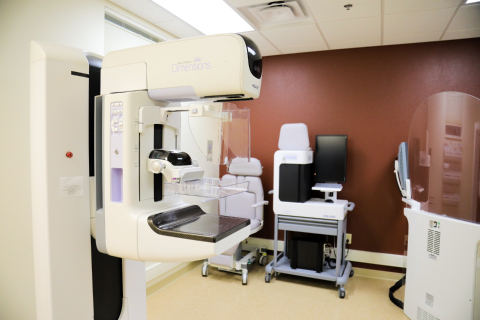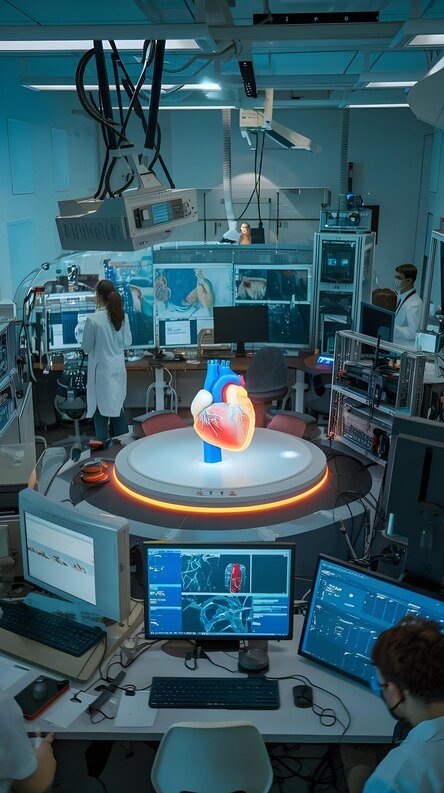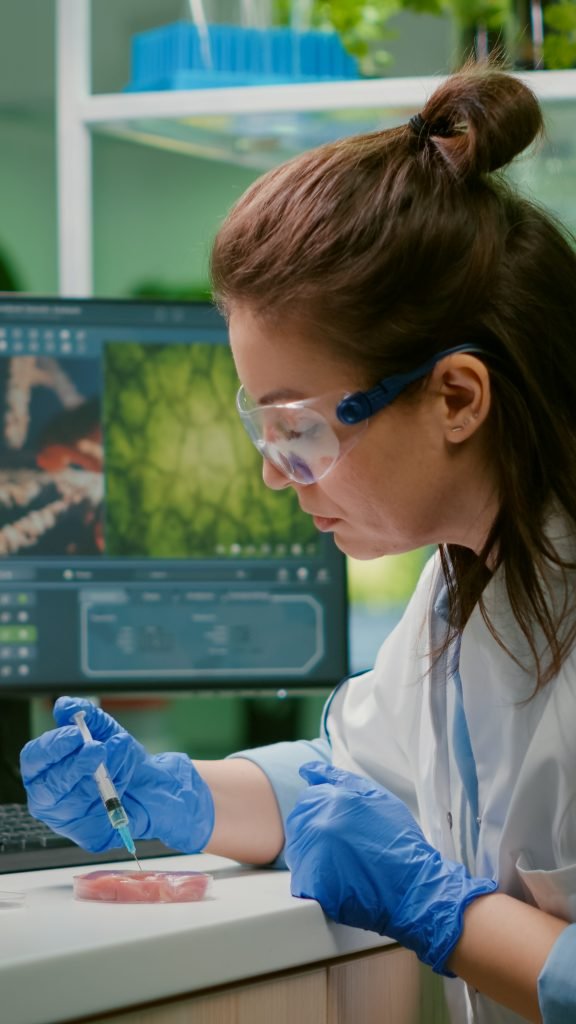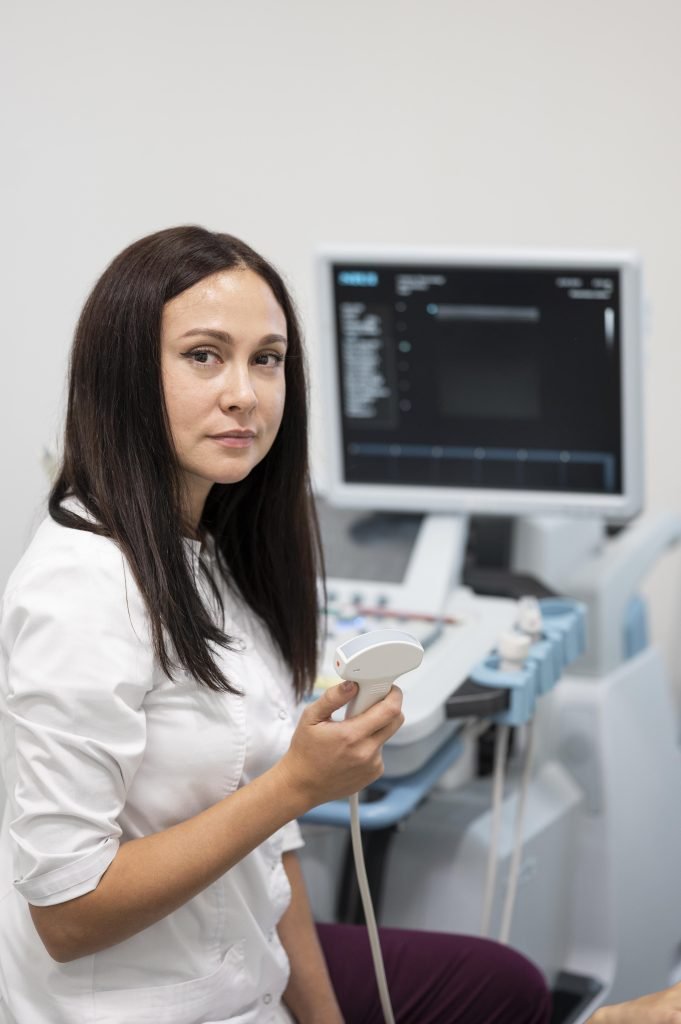Digital Memmography

Digital Memmography
A Mammography is an x-ray picture of the breasts. It is used to find tumors and to help tell the difference between noncancerous (benign) and cancerous (malignant) disease.

How the test is performed
You will be asked to undress from the waist up and will be given a gown to wear. you will sit or stand.
One breast at a time is rested on a flat surface that contains the x-ray plate. A device called a compressor will be pressed firmly against the breast to help flatten out the breast tissue.
The x-ray pictures are taken from several angles. You may be asked to hold your breath as each picture is taken.
Sometimes you will be asked to come back at a later date for more mammogram images. This does not always mean you have breast cancer. Rather, the doctor may simply need to recheck an area that could not be clearly seen on the first test.
Digital mammography is a newer technique that allows the x-ray image of the breast to be viewed and manipulated on a computer screen. It improves accuracy, but is not yet available everywhere.
How top prepare for the test
Do not wear deodorant, perfume, powders, or ointments under your arms or on your breasts on the day of the mammogram. These substances may obscure the images. Remove all jewelry from your neck and chest area.
Tell your health care provider and the radiologist if you are pregnant or breastfeeding.
How the test will feel
The metal may feel cold. When the breast is compressed, you may have some pain. However, this is necessary in order to obtain good images.
Why the test is performed
Mammography is performed to screen healthy women for signs of breast cancer. It is also used to evaluate a woman who has symptoms of a breast disease, such as a lump, nipple discharge, breast pain, dimpling of the skin on the breast, or retraction of the nipple.
Screening mammograms are improve the detection of early breast cancer, when it is more likely to be curable.
- Most but not all organizations recommend women began breast cancer screening at age 40 and have repeat mammograms every 1 to 2 years
- All women over age 50 should have a screening mammogram every 1 to 2 years
Women who have or had mother or sister with breast cancer should begin yearly mammograms earlier than the age the family member was diagnosed.


Breast ultrasound may also be used to screen women at high risk.
In addition to mammography, clinical breast exams (the health care professional checks the breasts using the fingers) and monthly breast self-exams are often recommended.
- Women age 20 and older should have a clinical breast exam every 3 years
- Women age 40 and older should have a clinical breast exam every year
All women age 20 and older perform monthly breast self-examination.
These are general recommendations for mammography, clinical breast exams, and breast self-exam. Women should discuss with their personal health care provider how often to receive breast cancer screening, including mammography and clinical breast exam. Recommendations vary depending on personal risk factors such a strong family history of breast cancer.
- Normal results
Breast tissue that shows no signs of a mass or calcification is considered normal.
- What abnormal results mean
A well-outlined, regular, clear spot is more likely to be a noncancerous condition such as a cyst.
A poorly outlined, cloudy area is more likely to suggest breast cancer. However, some cancers may appear well-defined.
Sometimes, the doctor will use ultrasound to further examine your breast and determine the next best step. When findings from a mammogram or ultrasound look suspicious, a biopsy is performed to determine if it a cancerous or noncancerous condition.
Contact Us to get more Information About Our Laboratory
- Risks
The level of radiation is low and any risk from mammography is exceedingly low. If you are pregnant and need to have an abnormality checked, your belly area will be covered and protected by a lead apron.
Routine screening mammography is not done during pregnancy or lactation.
- Considerations
Mammography is important because it can, in some cases, detect breast cancers before you can feel them with your fingers.
- Alternative names
Mammogram
Frequently Asked Questions
Digital Mammography is an advanced imaging technique that uses low-dose X-rays to create detailed pictures of the breast tissue. It's similar to traditional film mammography but uses digital technology to capture and store images, allowing for better image quality and easier analysis.
Your doctor may recommend a Digital Mammogram for:
- Routine breast cancer screening
- Follow-up on a suspicious area from a previous mammogram
- Evaluation of a breast lump or other symptoms
- Monitoring changes in breast tissue for patients with a history of breast cancer
During the procedure, each breast is compressed between two plates and X-ray images are taken from different angles. The digital images are immediately available for review on a computer screen. The entire process usually takes about 20-30 minutes.
Digital Mammography offers several advantages:
- Better visibility of the breast, particularly for women with dense breast tissue
- Lower radiation dose
- Ability to manipulate and enhance images for better analysis
- Easier storage and retrieval of images for comparison over time
Preparation is simple:
- Don't use deodorant, perfume, or powder on your breasts or underarms on the day of the exam
- Wear a two-piece outfit for easy undressing above the waist
- If possible, bring previous mammogram images if they were done at a different facility
- Inform our staff if you're pregnant or breastfeeding
Some women may find the breast compression uncomfortable, but it only lasts for a few seconds for each image. Our technicians at Dr. Vaya's Lab are trained to make the experience as comfortable as possible.
General guidelines suggest:
- Women aged 40-44: Have the choice to start annual mammograms
- Women 45-54: Annual mammograms recommended
- Women 55 and older: Can switch to mammograms every 2 years, or continue yearly screening
However, these are general guidelines. Your doctor can provide personalized recommendations based on your individual risk factors.
At Dr. Vaya's Lab, we strive for quick turnaround times. You can typically expect to receive your results within 2-3 business days. If there are any concerning findings, we will contact you promptly to discuss next steps.
Digital Memmography Categories
| Digital Mammogram |
| Screening Mammogram |
| Diagnostic Mammogram |
| Breast Ultrasound |
| Image-guided Biopsy |
| Follow-Up Imaging |

Digital Memmography
A Mammography is an x-ray picture of the breasts. It is used to find tumors and to help tell the difference between noncancerous (benign) and cancerous (malignant) disease.
How the test is performed
You will be asked to undress from the waist up and will be given a gown to wear. you will sit or stand.
One breast at a time is rested on a flat surface that contains the x-ray plate. A device called a compressor will be pressed firmly against the breast to help flatten out the breast tissue.
The x-ray pictures are taken from several angles. You may be asked to hold your breath as each picture is taken.
Sometimes you will be asked to come back at a later date for more mammogram images. This does not always mean you have breast cancer. Rather, the doctor may simply need to recheck an area that could not be clearly seen on the first test.
Digital mammography is a newer technique that allows the x-ray image of the breast to be viewed and manipulated on a computer screen. It improves accuracy, but is not yet available everywhere.
How top prepare for the test
Do not wear deodorant, perfume, powders, or ointments under your arms or on your breasts on the day of the mammogram. These substances may obscure the images. Remove all jewelry from your neck and chest area.
Tell your health care provider and the radiologist if you are pregnant or breastfeeding.
How the test will feel
The metal may feel cold. When the breast is compressed, you may have some pain. However, this is necessary in order to obtain good images.
Why the test is performed
Mammography is performed to screen healthy women for signs of breast cancer. It is also used to evaluate a woman who has symptoms of a breast disease, such as a lump, nipple discharge, breast pain, dimpling of the skin on the breast, or retraction of the nipple.
Screening mammograms are improve the detection of early breast cancer, when it is more likely to be curable.
- Most but not all organizations recommend women began breast cancer screening at age 40 and have repeat mammograms every 1 to 2 years
- All women over age 50 should have a screening mammogram every 1 to 2 years
Women who have or had mother or sister with breast cancer should begin yearly mammograms earlier than the age the family member was diagnosed.
Breast ultrasound may also be used to screen women at high risk.
In addition to mammography, clinical breast exams (the health care professional checks the breasts using the fingers) and monthly breast self-exams are often recommended.
- Women age 20 and older should have a clinical breast exam every 3 years
- Women age 40 and older should have a clinical breast exam every year
All women age 20 and older perform monthly breast self-examination.
These are general recommendations for mammography, clinical breast exams, and breast self-exam. Women should discuss with their personal health care provider how often to receive breast cancer screening, including mammography and clinical breast exam. Recommendations vary depending on personal risk factors such a strong family history of breast cancer.
Normal results
Breast tissue that shows no signs of a mass or calcification is considered normal.
What abnormal results mean
A well-outlined, regular, clear spot is more likely to be a noncancerous condition such as a cyst.
A poorly outlined, cloudy area is more likely to suggest breast cancer. However, some cancers may appear well-defined.
Sometimes, the doctor will use ultrasound to further examine your breast and determine the next best step. When findings from a mammogram or ultrasound look suspicious, a biopsy is performed to determine if it a cancerous or noncancerous condition.
Risks
The level of radiation is low and any risk from mammography is exceedingly low. If you are pregnant and need to have an abnormality checked, your belly area will be covered and protected by a lead apron.
Routine screening mammography is not done during pregnancy or lactation.
Considerations
Mammography is important because it can, in some cases, detect breast cancers before you can feel them with your fingers.
Alternative names
Mammogram
Contact Us to get more Information About Our Laboratory
Frequently Asked Questions
Digital Mammography is an advanced imaging technique that uses low-dose X-rays to create detailed pictures of the breast tissue. It's similar to traditional film mammography but uses digital technology to capture and store images, allowing for better image quality and easier analysis.
Your doctor may recommend a Digital Mammogram for:
- Routine breast cancer screening
- Follow-up on a suspicious area from a previous mammogram
- Evaluation of a breast lump or other symptoms
- Monitoring changes in breast tissue for patients with a history of breast cancer
During the procedure, each breast is compressed between two plates and X-ray images are taken from different angles. The digital images are immediately available for review on a computer screen. The entire process usually takes about 20-30 minutes.
During the procedure, each breast is compressed between two plates and X-ray images are taken from different angles. The digital images are immediately available for review on a computer screen. The entire process usually takes about 20-30 minutes.
Digital Mammography offers several advantages:
- Better visibility of the breast, particularly for women with dense breast tissue
- Lower radiation dose
- Ability to manipulate and enhance images for better analysis
- Easier storage and retrieval of images for comparison over time
Preparation is simple:
- Don't use deodorant, perfume, or powder on your breasts or underarms on the day of the exam
- Wear a two-piece outfit for easy undressing above the waist
- If possible, bring previous mammogram images if they were done at a different facility
- Inform our staff if you're pregnant or breastfeeding
Some women may find the breast compression uncomfortable, but it only lasts for a few seconds for each image. Our technicians at Dr. Vaya's Lab are trained to make the experience as comfortable as possible.
General guidelines suggest:
- Women aged 40-44: Have the choice to start annual mammograms
- Women 45-54: Annual mammograms recommended
- Women 55 and older: Can switch to mammograms every 2 years, or continue yearly screening
However, these are general guidelines. Your doctor can provide personalized recommendations based on your individual risk factors.
At Dr. Vaya's Lab, we strive for quick turnaround times. You can typically expect to receive your results within 2-3 business days. If there are any concerning findings, we will contact you promptly to discuss next steps.
Digital Memmography Categories
| Digital Mammogram |
| Screening Mammogram |
| Diagnostic Mammogram |
| Breast Ultrasound |
| Image-guided Biopsy |
| Follow-Up Imaging |
